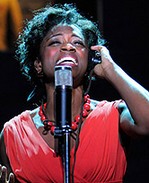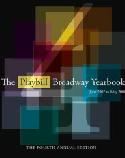SITE GUIDE
SEARCH
REVIEWS
REVIEW ARCHIVES
ADVERTISING AT CURTAINUP
FEATURES
NEWS
Etcetera and
Short Term Listings
LISTINGS
Broadway
Off-Broadway
NYC Restaurants
BOOKS and CDs
OTHER PLACES
Berkshires
London
California
New Jersey
DC
Connecticut
Philadelphia
Elsewhere
QUOTES
TKTS
PLAYWRIGHTS' ALBUMS
LETTERS TO EDITOR
FILM
LINKS
MISCELLANEOUS
Free Updates
Masthead
A CurtainUp Review
Memphis
|
Mama, Your heathen son is makin’ good on the radio.— Huey
|

Montego Glover
(Photo: Joan Marcus)
|
An extremely talented cast without a single name above the title has been collectively inspired to drive this original musical that happily isn’t a revival or a revamped movie musical. That’s right. It’s an original and that alone makes it deserving of extra points. Although the story was apparently inspired by real life DJ Dewey Phillip, who is credited for bringing "race" music to a white audience in the early 1950s, it is entirely fictional— and more than a bit facetious in the way the story is told. So, if you don’t mind staying one step ahead of a predictable plot, embracing a likable score that is meant to sound familiar but really isn’t, and being in the company of some decidedly one-dimensional characters, then this lively, if also shallow, show should fill the bill.
Set appropriately in Tennessee, the plot revolves around Huey (Chad Kimball), a Memphis native who envisions himself more than a stock room clerk in a downtown department store. Frequenting the juke joints along Beale Street, he becomes intensely excited about the soulful and rockin’ music he hears there. He is soon driven by his passion to bring black music to a white audience.
The musical follows his rather meteoric rise from a top-of-the-dial DJ to mainstream radio to headlining a successful TV show. That the white teenagers are soon dancing in the streets to the music that had been considered to appeal only to blacks (shades of Hairspray) is all the inspiration that choreographer Sergio Trujillo needs to initiate a flow of athletic dances, including a little double Dutch rope jumping by teenagers in the street.
Huey’s mission to integrate black music into the mainstream inevitably gets complicated when he falls in love with pretty black singer Felicia (Montego Glover) who belts out the blues in the dive run by her protective brother Delray (J. Bernard Calloway). Glover establishes her vocal capabilities right off the bat singing the bluesy "Underground. " She grabs the attention of Huey, the white outsider, who wastes no time, as dangerous as it is, to reveal his feelings for her even as he plans to guide her career. If only Glover was not encouraged to end her songs with that primal scream that seems to have infected so many singers these days! And is that really 1950s style?
It isn’t surprising that Delray disapproves of Huey’s relationship with Felicia, as does Huey’s intolerant Mama (Cass Morgan), who, as you might suspect early on, is primed to have an eleven-0’clock breakthrough gospel number. As Delray, Calloway scores big in a dramatic duo ("She’s My Sister") sung with Kimball, as does big man James Monroe Iglehart, as a fired-up janitor who not only dances but sings a rousing "Big Love" with rafter-shaking ease.
What gives this musical it’s most original touch, however, is the way Huey has been conceived as a virtually illiterate, almost nuttily compulsive eccentric. As played by a very game and garrulously impelled Kimball, Huey leaves no doubt in our minds that he isn’t meant to weather the prescribed denouement. Although Paul Tazewell has dressed the company smartly to the era, he might have to share credit with Barnum and Bailey for the get-ups that Huey wears.
While it may be accurate to say that the superficial takes precedence over the insightful in DiPietro’s script, it is also unashamedly an extension of the simplistic characters it serves. Bryan’s score can certainly be praised for capturing the pulse and the pop rockin’ rhythms of the era. I have no doubt that Bryan and DiPietro (collaborators on The Toxic Avenger) will be heard from again.
I am more inclined to attribute the real pleasure in this show to the vim and velocity of Ashley’s direction and to the work of choreographer Sergio Trujillo, who has created dances that are just as relentlessly energizing. David Gallo’s scenic designs, as admirably lighted by Howell Binkley, incorporate just enough visual ingenuity to evoke a radio and TV station, a shabby apartment, and the city streets. Just as in Memphis in the 50s, you may want to shout "Hockadoo" as you leave the Shubert Theater. That word has as much meaning as the show, and that may just be enough.
|
Memphis Book and lyrics by Joe DiPietro Music and lyrics by David Bryan Based on a concept by George W. George Directed by Christopher Ashley Choreography by Sergio Trujillo Cast: Chad Kimball (Huey), Montego Glover (Felicia), Derrick Baskin (Gator), J. Bernard Calloway (Delray), James Monroe Iglehart (Bobby), Michael McGrath (Mr. Simmons) and Cass Morgan (Mama) Music producer and supervisor: Christopher Jahnke Sets: David Gallo Costumes: Paul Tazewell Lighting: Howell Binkley Sound: Ken Travis Projection design: Mr. Gallo and Shawn Sagady Hair and wig design: Charles G. LaPointe Fight director: Steve Rankin Associate choreographer: Kelly Devine Orchestrations: by Daryl Waters and Mr. Bryan Musical director: Kenny J. Seymour Dance arrangements: August Eriksmoen Running time: 2 hours 20 minutes, plus intermission Shubert Theater, 225 West 44th Street (212) 239-6200. Reviewed by Simon Saltzman Thursday October 22nd |
|
Musical Numbers
| |
Act One
|
Act Two
|
|
REVIEW FEEDBACK Highlight one of the responses below and click "copy" or"CTRL+C"
Paste the highlighted text into the subject line (CTRL+ V): Feel free to add detailed comments in the body of the email. . .also the names and emails of any friends to whom you'd like us to forward a copy of this review. You can also contact us at Curtainup at Facebook or Curtainup at Twitter |
|
Subscribe to our FREE email updates with a note from editor Elyse Sommer about additions to the website -- with main page hot links to the latest features posted at our numerous locations. To subscribe,
E-mail: esommer@curtainup.comesommer@curtainup.com
put SUBSCRIBE CURTAINUP EMAIL UPDATE in the subject line and your full name and email address in the body of the message -- if you can spare a minute, tell us how you came to CurtainUp and from what part of the country. |






